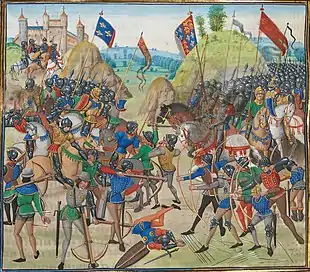John Dawney
Sir John Dawney or Dawnay (d.1346/7) was the eldest son of Nicholas Dawney (d. shortly before 15 Sep 1333)[1] of Mudford Terry, Somerset, and his wife, Elizabeth.
Sir John Dawney | |
|---|---|
 | |
| Died | 1346/7 |
| Spouse | Sybil Treverbyn |
| Children | Emeline Dawney |
| Parent | Nicholas & Elizabeth Dawney |
John Dawney's younger brother, Thomas Dawney of Escrick, Yorkshire, married Elizabeth, the daughter of John Newton of Snaith, Yorkshire, and was ancestor of the Viscounts Downe.[2]
John Dawney served in King Edward III's expedition to Honfleur in 1346, and fought at the Battle of Crécy on 26 August 1346, for which he was made a knight banneret.[3] He died shortly after the battle, in 1346/7.[4]
Dawney married Sybil Treverbyn, the daughter of Walter de Treverbyn of Treverbyn, Cornwall. They had one surviving child, a daughter Emeline or Emme (c. 1329 – 28 February 1371), who married Sir Edward Courtenay (c.1331 – 1368x1371), third son of Hugh Courtenay, 10th Earl of Devon, and by him had two sons, Edward and Hugh. The elder son, Edward (c. 1357 – 5 December 1419), inherited the earldom from his grandfather, the 10th Earl, and became 11th Earl of Devon. The 11th earl married Maud Camoys, and the earldom remained in their descendants until their great-grandson, Thomas Courtenay, 14th Earl of Devon, was beheaded at York on 3 April 1461 after the Battle of Towton, dying without issue. All his honours were forfeited by attainder, and the earldom eventually passed, after a brief period of confusion during the Wars of the Roses (for which see Earl of Devon), by a new creation in 1485 to Edward Courtenay, 1st Earl of Devon (d.1509), the grandson of Sir Hugh Courtenay of Haccombe and Bampton (1358–1425), brother of the 11th Earl.[5]
Emeline Dawney is said to have brought an estate consisting of "fifteen large manors in Cornwall" to the Courtenay family.[6]
Two effigies under a canopy in the south transept in the parish church of St. Peter and St. Paul at Sheviock, Cornwall, of a knight in gilded armour and his lady are considered to represent Sir Edward Courtenay and his wife, Emeline Dawney. A third effigy of a knight in the north aisle is said to represent Emeline's father, Sir John Dawney. The arms given by Lysons for the Dawney (Latinised to De Alneto[7]) family are 'Argent, on a bend cotized sable, three annulets of the field'.[8]
Footnotes
- CIPM, vol. 7, p. 350, No. 494.
- Lodge 1789, p. 73; Brydges 1812, p. 453; Burke 1832, p. 384.
- Lodge 1789, pp. 72–3.
- Lodge 1789, p. 73.
- Cokayne 1916, pp. 325–6; Richardson I 2011, pp. 546–7; Richardson IV 2011, p. 41.
- Lodge 1789, p. 72.
- From French d'Aulnay/d'Aulney, etc (The Conqueror and His Companions by J.R. Planché, Somerset Herald. London: Tinsley Brothers, 1874, re: Fulk D'Aulnay)
- Rogers 1877, pp. 364–5.
References
- Brydges, Egerton (1812). Collins's Peerage of England. Vol. VIII. London: F. C. and J. Rivington, Otridge & Son. p. 453. Retrieved 25 October 2012.
- Burke, John (1832). A General and Heraldic Dictionary of the Peerage and Baronage of the British Empire. Vol. I (4th ed.). London: Henry Colburn and Richard Bentley. Retrieved 26 October 2012.
- Cleveland, Duchess of (1889). The Battle Abbey Roll With Some Account of the Norman Lineages. Vol. I. London: John Murray. Retrieved 27 October 2012.
- Cokayne, George Edward (1916). The Complete Peerage, edited by Vicary Gibbs. Vol. IV. London: St. Catherine Press.
- Lodge, John (1789). The Peerage of Ireland. Vol. V. rev. by Mervyn Archdall. Dublin: James Moore. Retrieved 25 October 2012 – via archive.org.
- Richardson, Douglas (2011). Everingham, Kimball G. (ed.). Magna Carta Ancestry: A Study in Colonial and Medieval Families. Vol. I (2nd ed.). Salt Lake City. ISBN 978-1449966379.
{{cite book}}: CS1 maint: location missing publisher (link) - Richardson, Douglas (2011). Everingham, Kimball G. (ed.). Magna Carta Ancestry: A Study in Colonial and Medieval Families. Vol. IV (2nd ed.). Salt Lake City. ISBN 978-1460992708.
{{cite book}}: CS1 maint: location missing publisher (link) - Rogers, W. H. Hamilton (1877). The Ancient Sepulchral Effigies and Monumental and Memorial Sculpture of Devon. Exeter: William Pollard. ISBN 1460992709. Retrieved 26 October 2012.